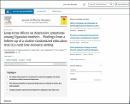| dc.contributor.author | Paul, Kakwangire | |
| dc.contributor.author | Prudence, Atukunda | |
| dc.contributor.author | Moses, Ngari | |
| dc.contributor.author | Ane, C. Westerberg | |
| dc.contributor.author | Per, O. Iversen | |
| dc.contributor.author | Grace, Muhoozi | |
| dc.date.accessioned | 2024-04-15T08:03:28Z | |
| dc.date.available | 2024-04-15T08:03:28Z | |
| dc.date.issued | 2024-04 | |
| dc.identifier.citation | Kakwangire, P., Atukunda, P., Ngari, M., Westerberg, A. C., Iversen, P. O., & Muhoozi, G. (2024). Long-term effects on depressive symptoms among Ugandan mothers–Findings from a follow-up of a cluster-randomized education trial in a rural low-resource setting. Journal of Affective Disorders, 351, 598-606. | en_US |
| dc.identifier.uri | https://doi.org/10.1016/j.jad.2024.01.263 | |
| dc.identifier.uri | https://hdl.handle.net/20.500.12504/1661 | |
| dc.description.abstract | Introduction
Depression is increasingly affecting mothers in poor countries such as Uganda. Various interventions have been implemented to tackle this problem, but their sustainability is under-researched. Here we present follow-up data on maternal depression six years after a cluster-randomized controlled maternal education trial in rural Uganda.
Methods
The intervention lasted six months and consisted of nutrition, hygiene, sanitation and child stimulation education, delivered to 511 mothers of 6 to 8 months' old children. Six years later we assessed maternal depressive symptoms using two psychometric tools; the Beck Depression Inventory II (BDI-II) and Center for Epidemiologic Studies Depression scale (CESsingle bondD).
Results
For this follow-up study, data was available from 307/511 (60 %) mothers. Intention-to-treat analyses adjusting for clustering showed that the intervention mothers had non-significantly less depression symptoms (absolute score difference − 2; 95 % CI -5 to 0; p = 0.07) on BDI-II, and borderline significantly less depression symptoms (absolute score difference − 3; 95 % CI -5 to 0; p = 0.05) on CES-D compared to the controls. For categorized depression scores, the control mothers had significantly higher proportion of women classified in the worse depression categories for both BDI-II and CESsingle bondD. We did not find any baseline characteristics associated with maternal depression.
Limitations
The BDI-II and CES-D tools are both self-reported and we cannot rule out the possibility of social desirability bias in reporting of depression symptoms.
Conclusion
Six years after the maternal education trial, some benefits on maternal mental health were sustained. More studies are warranted on sustainability and scale-up of such interventions. | en_US |
| dc.language.iso | en | en_US |
| dc.publisher | Journal of Affective Disorders | en_US |
| dc.subject | Mothers in poor countries | en_US |
| dc.subject | Maternal depression | en_US |
| dc.subject | Depressive symptoms | en_US |
| dc.subject | Uganda | en_US |
| dc.title | Long-term effects on depressive symptoms among Ugandan mothers – Findings from a follow-up of a cluster-randomized education trial in a rural low-resource setting | en_US |
| dc.type | Article | en_US |

